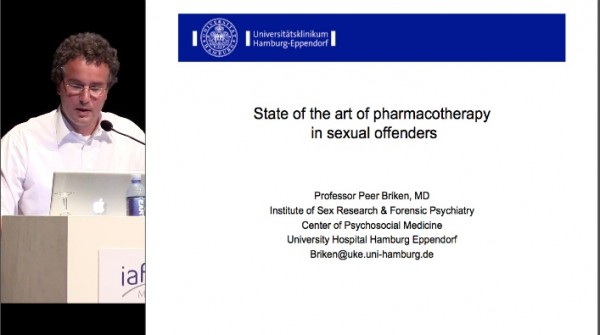The second Keynote address at the 2013 IAFMHS Conference in Maastricht, Netherlands was by Professor Peer Birkin, MD, a psychiatrist from the University Medical Center at Hamburg-Eppendorf, Germany. Dr. Birkin speaks about the state of the art of pharmacotherapy in sexual offenders.
Abstract
Effective rehabilitation of sexual offenders follows the principles of risk, need, and responsivity (RNR; Andrews and Bonta 2010) but also considers the well being of the offender. This lecture will provide an overview about the State of the Art and current guidelines (Thibaut et al. World J Biol Psychiatry. 2010 Jun;11(4):604-55) of pharmacological interventions for sexual offenders. Pharmacological treatment starts with a thorough diagnostic and prognostic process that examines the psychiatric disorders as well as the risk of the individual patient. There is a substantial knowledge about the wide range of psychiatric morbidity in sexual offenders. Treatment of impulsivity, anxiety and mood disorders for these men may also ameliorate sexual impulsivity, sexual preoccupation, hypersexual and/or paraphilic behavior. First line phar- macological treatment for patients with such a symptomatology and a low to medium risk for hands on offences are SSRIs. The prescription of testosterone lowering medication with cyporterone acetate or GnRH agonists could be rec- ommended for paraphilic sexual offenders with a moderate to high risk who are preoccupied with uncontrollable sexual fantasies and urges so that it is hard to work with them exclusively psychotherapeutically, and to those, who have severe problems with impulse control. Any pharmacotherapy of sexual offenders should be administered under conditions of free, informed consent and with a respect to human rights. It should always be part of a treatment plan that includes other possible and necessary interventions and should in- clude a rationale weighting of possible risks and benefits.
This is the second of four Keynote addresses given at IAFMHS 2013 in Maastricht. Keep an eye out for each of the four addresses to be posted as content on this site.
Here is the video of Dr. Birkin’s talk along with his slides. These slides are also posted to the IAFMHS 2013 website under Keynotes for those who would like to obtain a PDF of the slides.
The next post will be Dr. Ruth Man’s keynote on rehabilitation models for offenders. Stay tuned…








